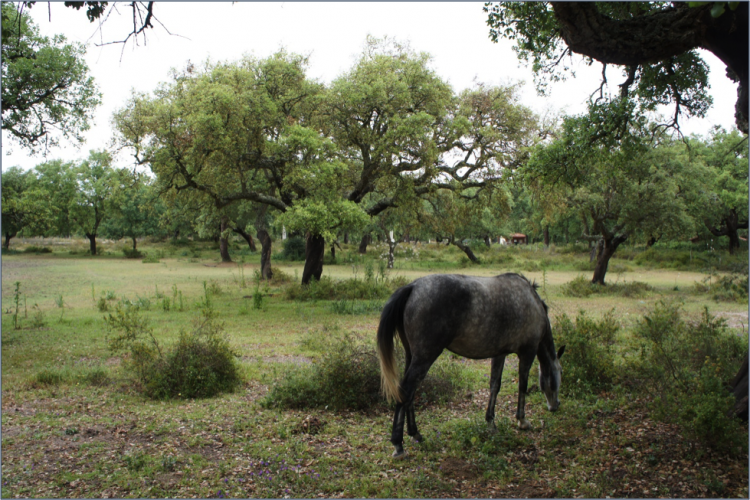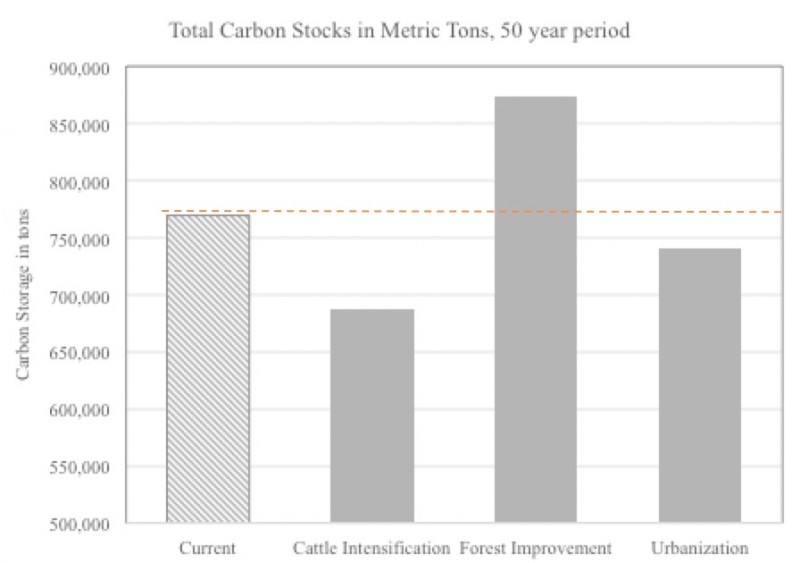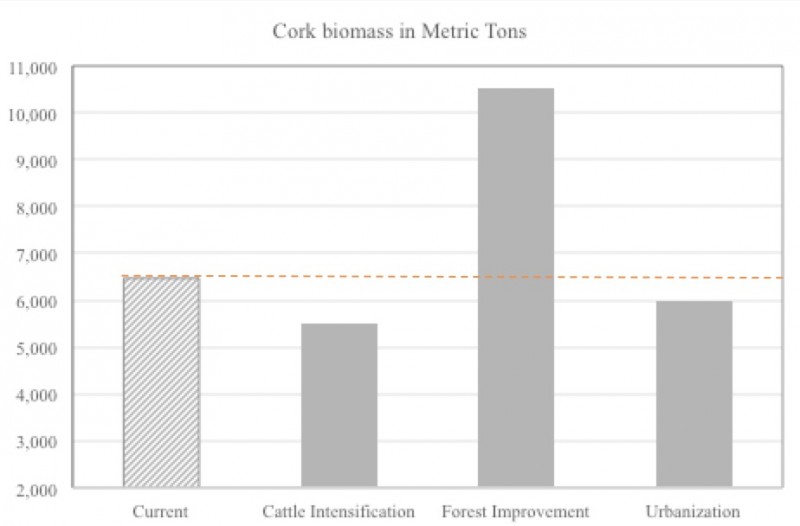
Walking through the Companhia das Lezírias farm, attentive observers will notice young horses grazing among cork oaks, tractors bringing in the latest harvest and, if lucky, a Black-winged Kite circling overhead. These are the features that made this landscape famous. But beside these visible attractions, Companhia – located in the heart of the Portuguese Alentejo region –also provides largely invisible benefits on a much larger scales: Ecosystem Services.
As the largest land-owner within the Portuguese Montado (a unique landscape with stands of Cork and Holm Oaks dotting grasslands traditionally used for livestock grazing and cork production), Companhia is the study area for the OPERAs Montado exemplar. For my Master’s thesis at Lund University, in collaboration with local exemplar partners, I analyzed ecosystem services in the Montado.
Specifically, I used the InVEST toolkit to quantify and map two services, Cork Production and Carbon Storage. Cork Production is an easily recognized service from growing cork oaks- it’s a “provisioning” service, meaning people directly use the cork products. Carbon storage, on the other hand, is a climate “regulating” service, where growing plants use photosynthesis to take carbon out of the air, thereby reducing the warming effect from carbon pollution in the atmosphere.
My analysis examined these two ecosystem services under current land use compared with three different future scenarios: Forest Improvement of the traditional Montado (with reduced cattle grazing and higher tree density), Cattle Intensification (with a reduced tree density and larger grazing areas), and Urbanization (the scenario closest to the current situation, which transforms 550 ha, about 10% of the property’s Montado landscape, into housing areas).
First, for the carbon results it’s not surprising that planting more trees would store more carbon, and this is what we found: Carbon Storage is highest under the Forest Improvement Scenario and lowest under Cattle Intensification (see Figure). In comparison to the current scenario, Forest Improvement stores 13.5 % more carbon (+103,000 Mg) whereas storage under Cattle Intensification drops by 11 % (-84,700 Mg). Urbanization remains close to the current land use and shows a carbon release of 30,000 Mg over 50 years (-3.76 %).
The ecosystem service concept is not only used to analyze the existing services in a given landscape but can also serve as a basis for monetary evaluation and, eventually, for a payment program to recognize the value that landscapes are providing, especially those values currently outside the market. Thus, I also calculated the market values of carbon sequestration and cork production for the study area. For carbon sequestration we assumed that the market value is equal to the social value of USD 66 Mg-1. In other words, offsetting a one-way flight from Berlin to Atlanta using this value would cost around $6,500 USD. Sequestration value is highest for Forest Improvement with an estimated $2.02 million USD, while Cattle Intensification shows a net release of carbon over the time period, which leads to a monetary loss of $1.65 million USD. The value of sequestration under Urbanization is a loss of $0.58 million USD.

Figure: Total carbon stocks in metric tons of carbon under the current and three future scenarios for a period of 50 years. In comparison, the per capita CO2 emission of a Portuguese person over the same period are 235 tons, meaning that Companhia currently stores enough carbon to balance the emissions of 3,200 people (base value: 2011, see data.worldbank.org).
Turning from an ecological to an economic measure, we see even bigger gains to be had from expanding cork production. An analysis of cork production follows the same trend as the carbon results. I looked into the production of cork biomass and its monetary value for the study area over a 50 year period. Under Forest Improvement cork production rises from currently 6,500 Mg to 10,500 Mg or, in monetary terms, from currently €2.00 million euro to €3.26 million euro. Again, Urbanization shows only a slight decline of 7.6% in comparison to the current land composition. Cork production under the Cattle Intensification scenario is just half as much as under Forest Improvement meaning a loss of profit of more than €1.5 million euro.
The results show that besides an aesthetic and cultural component, a traditional and forest-centered management of the landscape generates additional ecosystem service value, in this case $5.5 million USD at an exchange rate of USD 1.08 to EUR 1. This includes the monetary value of carbon sequestration and cork production for the study area.

Figure: Total profit of cork production over 50 years under current and three future land use scenarios. The total profit was calculated by applying an average market price of 15 € kg-1 to the harvested biomass subtracted by harvest and maintenance costs.
So, how can we use this information? Often, the value of ecosystem services are not known to decision makers and land-owners, and therefore is not factored into their decision making. Showing the hidden values which slumber in the Montado landscape could tip the scale in favor of more sustainable, forest-centered management. Expressing the cork production and carbon storage and sequestration in monetary terms helps to put the results into perspective and can be used as a starting point for a payment for ecosystem service scheme. Further, monetary values are easier to grasp for all stakeholders and are readily implemented into cost-benefit analyses. My results show that the a forest-centered land management could generate ecosystem services with a monetary value more than 25 times higher in comparison to the values generated under a management option which focuses on cattle breeding.
After four months of research and intense writing I found that the Montado is a fascinating landscape which offers not only recreation for humans and habitat for many endangered species, but also provides high levels of ecosystem services when managed in a traditional and sustainable way. With my research I hope to contribute to improve the valuation of the Montado landscape and further to identify and quantify these values. Ideally, this will help to keep the pressures that threaten the Montado at bay and preserve this unique landscape for future generations.
